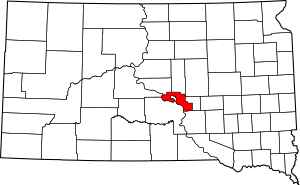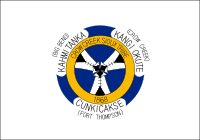Crow Creek Indian Reservation facts for kids
Quick facts for kids
Crow Creek Indian Reservation
|
||
|---|---|---|
|
||

Location of Crow Creek Indian Reservation, South Dakota
|
||
| Country | United States | |
| State | South Dakota | |
| Counties | Buffalo / Hughes / Hyde | |
| Area | ||
| • Total | 196.235 sq mi (508.248 km2) | |
| Population
(2004)
|
||
| • Total | 1,230 | |
| Time zone | UTC-6 (CST) | |
| • Summer (DST) | UTC-5 (CDT) | |
| Website | South Dakota Tribal Government Relations: Crow Creek Sioux Tribe | |
The Crow Creek Indian Reservation is the home of the Crow Creek Sioux Tribe. It is located in central South Dakota, on the east side of the Missouri River. The reservation covers parts of Buffalo, Hughes, and Hyde counties.
In 2000, about 2,225 people lived here. The main town and capital of the Crow Creek Sioux Tribe is Fort Thompson. This town is near the Big Bend Dam. This dam creates Lake Sharpe, a large lake on the Missouri River. The dam was built in the 1960s to help control floods and create electricity.
Contents
History of the Crow Creek Sioux Tribe
The people of the Crow Creek Sioux Tribe are mostly descendants of the Mdewakanton Dakota Tribe. They originally lived in what is now south and central Minnesota. In 1862, after the Dakota War, they were forced to leave Minnesota. Other tribes, like the Santee Dakota and Ho-Chunk Nation, were also moved to this new reservation.
The land at Crow Creek was very different from their old homes. It was dry and didn't have much game for hunting. Many people became sick or starved. Because of this, the Santee and Ho-Chunk tribes later moved to other areas. Some Yankton and Yanktonai Dakota people also live on the reservation. The Crow Creek Reservation was created in 1862 and has always been separate from the larger Great Sioux Reservation.
The reservation once included fertile lands along the Missouri River. These lands were farmed by earlier tribes like the Mandan and Arikara. Sadly, many of these people died from diseases in the 1700s. The remaining Mandan, Hidatsa, and Arikara tribes moved north. Today, you can find old village sites within the Crow Creek Reservation. These are important archaeological sites.
Ancient Cultures and Discoveries
There are two very old archaeological sites on the reservation. They are so important that they are called National Historic Landmarks.
- The Fort Thompson Mounds are burial mounds along the river. They were built around 800 CE. These sites show evidence of some of the first people to make pottery on the plains. Some older items found here are nearly 5,000 years old.
- The Crow Creek Massacre Site shows signs of a big conflict around 1325 CE. This likely happened when different groups were fighting over resources.
Life in the 20th Century and Today
In the 1960s, the Big Bend Dam was built. This created Lake Sharpe and flooded much of the fertile land on the reservation. This made life harder for the tribes. Over time, the size of the reservation also became smaller due to government actions.
The Crow Creek Sioux Tribe has its own government. The reservation is divided into three districts. The tribe also runs its own school system, called Crow Creek Tribal Schools. There is an elementary school in Fort Thompson and a K-12 school in Stephan.
Most of the reservation land is used for grazing animals. It's not easy to farm here. Many people on the reservation face unemployment. To help the economy, the tribe runs the Lode Star Casino and Hotel. The old archaeological sites also attract visitors interested in history. People also enjoy fishing and boating on Lake Sharpe.
The Lower Brule Indian Reservation is located across the Missouri River. Its people also lost land when the dam was built.
Remembering the Dakota War of 1862
In 2002, a special monument was built at Big Bend Dam. It's called the Spirit of the Circle Monument. This monument honors more than 1,300 people who died at the reservation in the 1860s. They died from hunger and cold after being forced to move from Minnesota. Many members of the Ho-Chunk nation also died here, even though they were not involved in the Dakota War of 1862.
On May 10, 2013, the governor of Minnesota, Mark Dayton, held a "day of reconciliation." This was about 150 years after a past governor had called for the Dakota people to be removed from Minnesota. Governor Dayton apologized for the past actions and offered sympathy to the families who lost loved ones.
Tribal Information at a Glance
- Reservation: Crow Creek Reservation
- Counties: Buffalo, Hyde, and Hughes counties
- Tribal Groups: Santee, Yankton
- Bands: Mdewakanton (People of Spirit Lake), Ihanktonwan (People of the End)
- Land Area: About 125,591 acres (508.248 km²)
- Tribal Headquarters: Fort Thompson, SD
- Time Zone: Central Time
- Traditional Language: Dakota
- Members Living on Reservation: 1,230 (as of 2004)
- Main Industry: Agriculture (mostly grazing)
Tribal Government and Elections
The Crow Creek Sioux Tribe has an elected government.
- Elections: All six council members and the chairman are elected every two years. Elections happen on the third Tuesday in April.
- Chairman: The chairman is elected by all voters on the reservation.
- Council Members: Two council members are elected from each of the three districts.
- Tribal Council Roles: The Tribal Council chooses a vice-chairman, Treasurer, and Secretary from among its members.
Council Meetings
- Regular Meetings: The Tribal Council meets once a month.
- Quorum: At least 4 members must be present for a meeting to make official decisions.
Notable People from the Tribe
- Oscar Howe (1915–1983): A famous Yanktonai modernist painter. He grew up on the Crow Creek Reservation. He received many awards and was named Artist Laureate of South Dakota. You can see his art in museums and centers, including the Oscar Howe Art Center.
- Elizabeth Cook-Lynn: A writer who taught Native American Studies for 20 years. She has written novels and short stories. She also edits a journal about Native American studies. She grew up on the Crow Creek Reservation and is a traditional dancer.
- Shawn Hawk: A professional boxer with family ties to Crow Creek.
- Vernon Ashley (died 2015 at age 99): He was the oldest member of the Crow Creek Sioux Tribe. He was honored in the South Dakota Hall of Fame. He knew a lot about Native American laws and the Dakota Sioux language. He helped create the tribe's constitution in 1948.


